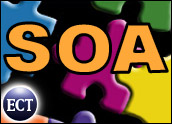
“SOA transition” is buzz term growing in popularity among IT managers, especially when they meet with corporate boardroom residents. Businesses are transitioning into service-oriented architecture by tapping into the increasing number of SOA products software makers are creating to meet this new interest.
However, for the uninitiated, SOA can be just another entry in themushrooming jumble of acronyms and alphabet soups business technology users must digest. The world of e-commerce is undergoing a transition toward greater use of SOA. Its proponents claim that SOA holds real promise to drive further adoption and greater efficiency for e-commerce.
SOA can be a powerful asset for IT organizations, enabling them to unite disparate systems using well-defined, common standard interfaces. Do not view SOA as a new technology, however. It is a flexible business process that can help adopters cost-effectively deliver increased value to their customers.
Rather than throwing investment money into “rip and replace” strategies that involve complete software rewrites, application modernization with SOA enables organizations to reuse valuable business logic within applications that can seamlessly integrate with newer, Web-based systems.
“SOA helps businesses expose their business functions to externalcustomers via a standard interface through Web services. Within eachorganizations is an expansive set of software and systems thatoftentimes hold more value than IT leaders realize,” Craig Marble,manager of technical services for Micro Focus,told The E-Commerce Times.
Need a Plan
Successfully transitioning into SOA usually requires more planning than making a decision to adopt a typical new technology product. As a starting point, companies need to look at what they have so they more clearly understand the IT services they offer. Then corporate managers candecide what’s needed and what’s not when customers are given accessto online integrated services, according to Marble.
“Companies can design a Web front-end on an application. But to allowintegration of all their services takes an SOA approach,” he said.”Rewriting software is not a good option. It takes a lot of money togo from Cobol to Java.”
Another plan is to rely on an a systems, applications and products(SAP) solution. But that approach limits functionality and stillrequires companies to customize, he explained. So it is better totake what a company has and extend it to SOA. This method lowers therisk and is generally cheaper. The real benefit with SOA comes with being able to reuse existing business logic.
The Right Approach
The transition path a company uses toward SOA can make the differencebetween success and failure. Software vendors offer a variety ofoptions for getting the job done.
“Increasingly, IT organizations are looking to move to SOA. Far frombeing bleeding-edge early adopters, these mainstream IT executives andarchitects are looking for practical ‘do’s and don’ts’ as they getstarted down the path,” Mahau Ma, senior director of marketing forMuleSource, told The E-Commerce Times. MuleSource provides open SOA infrastructure software.
Dealing with a transition to SOA is not rocket science — it’s mostlyold stuff in a new package, Marble noted.
“SOA is not a technology. It is an idea or concept about how youdeliver a product to your customer,” he said.
Some Do’s
MuleSource has tracked its customers’ experiences in migrating to SOA.Ma offered a short list of how to approach the task effectively.
First, pick a well-defined project with a limited scope and fewexternal dependencies to quickly prove out the return on investment(ROI) and derive learning and best practices. Second, understand whatthe primary goals are for your organization’s move to SOA and focus onhow to achieve — and measure — success. For instance, is the companydefining success as development savings, business agility or lowermaintenance costs?
Third, select the right tools and services that work for yourparticular environment and organization. Fourth, think ahead to SOAgovernance issues. Consider how you will keep track of developmentartifacts and services as the infrastructure scales. Also think abouthow to ensure SOA best practices and how to enforce developmentpolicies.
Some Don’ts
MuleSource has a list of approaches best avoided when migrating to SOA.
One, do not assume that SOA equals a product. It is a developmentapproach that can be supported by software tools such as an Enterprise Service Bus (ESB); however, beware of any vendor that promises that their “suite” ofproducts will deliver your ESB.
Two, do not try to re-architect your enterprise at once. Manyorganizations make a huge up-front investment in software anddevelopment, hoping for a return over 18 months to three years. Thatapproach is fraught with risks.
Three, do not forget to think about organizational and behavioralchanges that SOA requires. For instance, get answers to questions: What is the impact on the average developer’s day-to-dayactivities? What new skills are required? How do you enforce goodgovernance?
HP’s Approach
There’s apparently room enough in the wide world of SOA for differing philosophies and industry marketing strategies. While MuleSource calls SOA a development approach rather than a product, other companies have developed products specifically to aid companies in their SOA approaches. For example, HP recently announced its third generation of SOA solutions, Systinet3. The goal is to help users realize a quicker return on SOA investment. It’s a set of integrated software to help companies manage their SOA from the start.
“This is not middleware. We provide IT managers a GPS (global positioning system) for SOA. The process requires a change in how IT works,” Kelly Emo, SOA productmarketing manager for HP Software, told the E-Commerce Times.
HP offers tools for three areas — governance, quality assurance and SOA management.
“One challenge is most companies have no general tendency to coordinate between quality and assessment and the network. A bigger challenge is to roll out SOA in a big operation. It’s tough to meet goals,” Emo said.
A Micro Focus View
EnterpriseView by Micro Focus is a tool that helps companies assess their business environment for information management. Then it helps the companies to plan for enabling their service under SOA. SOA Express is a tool that generates the service for a company’s customers.
“People are realizing that their legacy applications have value,” said Marble, and businesses are learning that they can migrate their existing softwareto other platforms for cheaper operation.
New From IBM
IBM announced this month it’s enhancing its SOA market offeringswith a series of new products and services that will help clients takeadvantage of rapid changes in the marketplace in order to gain acompetitive advantage.
These include new versions of key platforms, including WebSphereApplication Server and WebSphere MQ. The availability of WebSphere MQFile Transfer Edition will introduce file transfer services that useMQ as a backbone to enable clients to simplify the transfer andauditing of files and documents. This capability will be crucial forfinancial organizations that must comply with government stricterregulations that are sure to come on the tail of the Wall Streetfallout, the company said.
Other enhancements include SOA frameworks for the government andbanking industries. Also part of the SOA rollout is a set of key agilityindicators that help clients monitor the success of their businessplans and compare these results to their competitors in themarketplace.
These indicators can be imported into IBM WebSphere Business Modelerand take advantage of the IBM business process management portfolio tohelp businesses to set their objectives and begin to outline newprocesses.





















































Social Media
See all Social Media